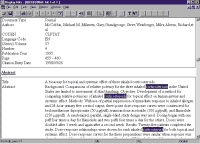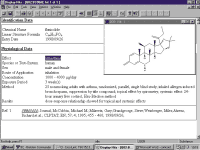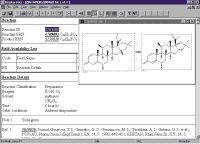EcoPharm
Beilstein launched the unique database CrossFire EcoPharm. The EcoPharm module is an ‘add-on’ to CrossFire.
Having all the advantages of the CrossFire System, this new database will be implemented with an improved data structure, especially in areas such as pharmacology, toxicology, and ecological chemistry.
| Pharmacological and toxicological data focus on human and mammalian toxicology, drug treatment, pharmaceutical and biochemical chemistry. | ||
| Ecological data are concerned with effects of chemicals on various ecosystems, their environmental fate and potential for accumulation as well as health threat in the environment. |
CrossFire EcoPharm Data Structure
| Pharmacological Data | ||||||
| Ecological Data | ||||||
| Ecotoxicology | ||||||
| Exposure | ||||||
| Exposure assessment | ||||||
| Concentration in the environment | ||||||
| Mobility (spread in the environment) | ||||||
| Transport and Distribution | ||||||
| Bioaccumulation | ||||||
| Biomagnification | ||||||
| Biomonitoring | ||||||
| Reactivity (Transformation) | ||||||
| Biodegradation | ||||||
| Abiotic Degradation, Hydrolysis | ||||||
| Abiotic Degradation, Photolysis | ||||||
| Stability in Soil | ||||||
| Oxygen Demand | ||||||
| Use | ||||||
In combination with fitting physical chemical properties such as Henry Constant, Partition Coefficient (n-octanol/water), Solubility, etc., the new database enables chemists and related scientists to get an instant access to the entire scope of pharmacological and environmental sciences.
The source list was expanded about 180 leading international relevant journals. For more information about the coverage of EcoPharm.
Whether you are interested in synthesis planning, in pharmacological evaluation of existing or new therapeutic agents, or in exposure assessment of environmental chemicals, CrossFire EcoPharm provides you with answers to the following typical questions:
| Has a specific substance been synthesized and published yet? | ||
| Which properties or effects have been investigated? | ||
| Which test results are available, which species have been tested? | ||
| Which structure elements are responsible for effects (SAR)? | ||
| Are intermediates in a synthesis plan toxic to humans or the environment? | ||
| Where have chemicals been found in the environment? | ||
| What are the natural or artificial contamination sources? | ||
| Are environmental chemicals stable in soil, water or in the air? | ||
| Are they accumulated in organisms? | ||
| Do they find their way into the food chain (biomagnification)? |
In the terrain of factual and bibliographic databases of organic substances, CrossFire EcoPharm is outstanding in providing structures, facts, reactions, citations, abstracts and unlimited combinations of search possibilities.
The following example shows how different context searches – a unique feature of CrossFire – can be combined.
We start with a general question concerning ‘corticosteroid therapy’ in a typical bibliographical way based on the journals, which are known to be efficient sources for substances and data. The result provides us relevant substances, which appear in articles dealing with this specific subject.
 Example 1: Context: Citations; Search term: „corticosteroid" |
Although at this stage we
have a great deal of valuable information on publications with our
search term, what we are really interested in is specific
pharmacological properties associated with the substances cited in those
references.
In CrossFire EcoPharm, as with any other
CrossFire product, this is easily accomplished by means of the powerful
context switch to substance. With a substance hit-set deriving from
those articles now available, further refinement with a property such as
‘antiasthma effect’ can be easily achieved. |
|
 Example 2: Context: Substances; Factual search; Search term: „antiasthma" |
In Example 2, we see the direct link of the effect ‘antiasthma’ with the substance. Numerical values and test parameters are provided immediately. We now do not need to read the original articles to see if there was relevant data for our substance. It can all be done in seconds. | |
 Example 3: Context: Reactions; Reaction Search; Search term: Structure of „flunisolide" as reactant |
A question about the synthesis of a substance can be answered easily by means of the reaction search. |
|
|